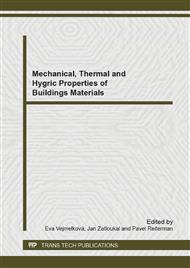p.1
p.6
p.11
p.16
p.22
p.27
p.32
p.38
Adsorption of Water Vapor in Selected Sandstone Influenced by Different Method of Measurement Using Dynamic Vapor Sorption Device
Abstract:
In this paper, water vapor adsorption in sandstone is analyzed using different measurement setting of dynamic vapor sorption device. Basic physical properties of tested material are determined. The vapor sorption is measured using different experimental time and dm/dt setting. It is shown that the device setting can influence the results of equilibrium moisture content in high relative humidities, whereas the differences are of about 20%. The measurement also indicates that the difference in hysteresis can be up to 50% for non-equilibrium measured sample compared to the one under equilibrium state. Both measurements are compared with the steady state desiccator method. The sandstone samples containing a certain concentration of inorganic water soluble salt which just only emphasizes the low hygroscopicity of silica grains are studied as well. The measured data can be used in evaluating of results obtained by dynamic vapor sorption device under equilibrium states although the measurement takes significantly longer time.
Info:
Periodical:
Pages:
16-21
Citation:
Online since:
July 2014
Authors:
Price:
Сopyright:
© 2014 Trans Tech Publications Ltd. All Rights Reserved
Share:
Citation:


